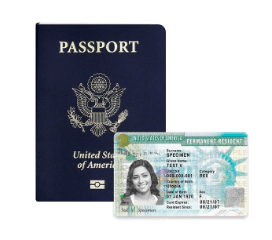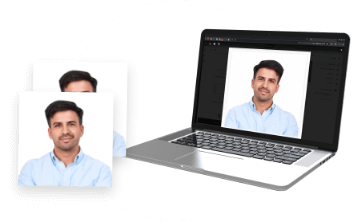Why download our APP?
If taking Passport Photos has become a difficult process for you and your family, we recommend that you download our Passport Photos App and get a seamless, error-proof experience thanks to mobile technology and our experts.

Questions?
Is iVisa.com a legitimate company?
Our Company is accredited and recognized by the International Air Transport Association (IATA) and has a validated IATA Agency Code. If you want to check this information you can verify our membership using our bearing No. 23716873 at http://store.iata.org/ieccacfree.
Remember that the customer service team at iVisa.com is here 24/7 to answer any questions you may have about our service.
Get your Visa Photo Online Now!
There is one thing that people who want to enter other countries must understand the importance of a visa photo. It’s no secret that even frequent travelers overseas can get into a bit of trouble if they have the incorrect photo on their visa applications. Their application will invariably be denied and travel plans may change or be canceled entirely.
What is a Visa?
Basically, a visa is a document that allows a person to travel to another country, one in which he/she is not a citizen. It is the paperwork that is officially delivered by the country’s foreign affairs personnel, and, in most cases, is valid only for a certain amount of time.
There are some visas that are valid for a lifetime. One example is the Diversity Immigrant Visa or the green card of the United States, which grants immigrants the ability to travel in and out of the United States anytime they want. Visa applications are usually handled in person at the host country’s consulate or embassy.
As implied previously, there are many types of visas. Here are some of the more common types and their uses:
- Work visa – these are documents that are required for people who want to work in the host country. Under the work, visa category are several types of visas that are provided for migrant workers depending on the length of their stay and the nature of their work. One example is the working holiday visa where the traveler can take on paid work in the host country while traveling.
- Business visa – this is closely related to the work visa, but this type offers the added benefit of the person holding being able to work without officially joining the host country’s labor force. An individual representing a company may need a business visa to attend a business conference or conduct business with another company located in another country.
To acquire this type of visa usually requires the visiting individual to show that the income they receive is not from the labor market of the host country.
- Student visa – is a type of visa that allows a person who carries it enroll in an educational institution, usually a post-secondary one, in the host country. Typically, these are used to allow enrolment to top universities. It is a type of non-immigration visa but still allows the bearer temporary residence in the host country.
- Transit visa – are provided for travelers that only wish to enter a country in order to get to another country, which is their intended destination. For example, people wishing to pass through India to get to Nepal may be required to apply for a transit visa depending on their point of entry. The conditions for acquiring a transit visa may change from country to country depending on their immigration laws.
- Spousal visa – these documents allow married partners to visit their spouses when they are living in different countries. As is the case of transit visas, these may or may not be required by the host country. Spouses may also acquire another type of visa to visit each other in lieu of a spousal visa if it is not available in the host country.
- Refugee/asylum visa – these are visas that are provided for individuals who are fleeing from religious persecution, natural disasters, war, and situations that may put their lives at risk. These can sometimes be precursors for green cards or Diversity Immigrant Visas in the United States since the country aims to diversify their immigrant populace.
- eVisa – as the name implies, it is a visa that is stored in a digital database. In contrast to other types of visas, these are not stamped on to the traveler’s passport but are linked to the passport number of its bearer. Most applications are typically done online, and the process concludes with the applicant receiving a file that can be printed and presented to immigration officers while traveling.
What is an Acceptable Visa Photo?
Obtaining the correct photo for a visa application is of utmost importance. There’s no telling how many days or weeks or months an individual’s travel plans may be delayed because of an incorrect photo botching a visa application. Travelers may spend hundreds or thousands of dollars on a skiing or photography trip to another only to find out that their visa application has been denied because the photo is unacceptable. Visa photos may change with the host country (some may not even require one), but we will have the requirements for a United States visa as our example.
Here are the requirements for a US visa photo:
- The size must be 2 inches by 2 inches, the aspect ratio of a perfect square. It must be taken by a digital camera or scanned digitally from a 2-inch by 2-inch paper photograph. If taken through a digital camera, the minimum should be 600 pixels on each side, with the maximum acceptable dimensions having 1200 pixels on each side.
- It should be in color, and the format should be in jpeg.
- The size of the file must be 240 kB (kilobytes) at the most.
- The age of the photo must be within 6 months prior to the application and must reflect the entrant’s current appearance.
- The entrant should face the camera fully and should be standing in front of a white or off-white background. Patterns are not acceptable.
- The photo should clearly show all facial features of the entrant and the face area should not be obscured by hats or other headwear.
- The photo should not include anything other than the entrant.
- Eyeglasses are prohibited except in cases where the eyewear cannot be removed due to medical reasons.
- The entrant should wear clothes that one wears daily, except for uniforms.
It’s easy to mess up even the simple things. Let the experts help you get the perfect visa photo so you can plan your trip without worries. Visit iVisa Photo services for more details.
Types of photo served by iVisa:
Read more about our photo service
- 5 Easy tips to get a perfect passport photo
- Afghanistan Passport/Visa Photo Requirements and size
- Albania Passport/Visa Photo Requirements and size
- Australia Passport / Visa Photo Requirements and Size
- Austria Passport/Visa Photo Requirements and Size
- Azerbaijan Passport / Visa Photo Requirements and Size
- Baby Passport Photo Requirements
- Bahamas Passport/Visa Photo Requirements and Size
- Bahrain Passport/Visa Photo Requirements and Size
- Bangladesh Passport/Visa Photo Requirements and Size
- Barbados Passport/Visa Photo Requirements and Size
- Belarus Passport/Visa Photo Requirements and Size
- Belgium Passport / Visa Photo Requirements and Size
- Belize Passport/Visa Photo Requirements and Size
- Benin Passport/Visa Photo Requirements and Size
- Best ID Photo App
- Best ID Photo Print Service
- Bhutan Passport/Visa Photo Requirements and Size
- Bolivia Passport/Visa Photo Requirements and Size
- Bosnia and Herzegovina Passport/Visa Photo Requirements and Size
- Botswana Passport/Visa Photo Requirements and Size
- Brazil Passport / Visa Photo Requirements and Size
- Brunei Passport/Visa Photo Requirements and Size
- Bulgaria Passport/Visa Photo Requirements and Size
- Burkina Faso Passport/Visa Photo Requirements and Size
- Burundi Passport/Visa Photo Requirements and Size
- Cambodia Passport / Visa Photo Requirements and Size
- Cameroon Passport/Visa Photo Requirements and Size
- Canada Passport / Visa Photo Requirements and Size
- Cape Verde Passport/Visa Photo Requirements and Size
- Chad Passport/Visa Photo Requirements and Size
- Chile Passport/Visa Photo Requirements and Size
- China Passport and Visa Photo: Requirements and Size
- Colombia Passport/Visa Photo Requirements and Size
- Comoros Passport/Visa Photo Requirements and Size
- Comparing the Requirements of Standard ID Photos
- Congo Passport/Visa Photo Requirements and Size
- Costa Rica Passport/Visa Photo Requirements and Size
- Create a Green Card Photo with iVisa Photos
- Create ID Photos with MyPassportPhotos
- Croatia Passport/Visa Photo Requirements and Size
- Cuba Passport/Visa Photo Requirements and Size
- Cyprus Passport/Visa Photo Requirements and Size
- Czech Republic Passport / Visa Photo Requirements and Size
- Denmark Passport / Visa Photo Requirements and Size
- DIY Passport Photo | How to Take Passport Photos at Home
- Djibouti Passport/Visa Photo Requirements and Size
- Dominica Passport/Visa Photo Requirements and Size
- Dominican Republic Passport/Visa Photo Requirements and Size
- East Timor Passport/Visa Photo Requirements and Size
- Ecuador Passport/Visa Photo Requirements and Size
- Egypt Passport/Visa Photo Requirements and Size
- El Salvador Passport/Visa Photo Requirements and Size
- Equatorial Guinea Passport/Visa Photo Requirements and Size
- Eritrea Passport/Visa Photo Requirements and Size
- Estonia Passport/Visa Photo Requirements and Size
- Ethiopia Passport/Visa Photo Requirements and Size
- Fiji Passport/Visa Photo Requirements and Size
- Finland Passport / Visa Photo Requirements and Size
- FOID Card Photo Requirements and Size
- France Passport / Visa Photo Requirements and Size
- Gabon Passport/Visa Photo Requirements and Size
- Gambia Passport/Visa Photo Requirements and Size
- Georgia Passport/Visa Photo Requirements and Size
- Germany Passport / Visa Photo Requirements and Size
- Germany Passport/Visa Photo Requirements and Size
- Ghana Passport / Visa Photo Requirements and Size
- Greece Passport / Visa Photo Requirements and Size
- Green Card and DV Lottery Photos Check Services
- Green Card and DV Lottery Photos Requirements
- Grenada Passport/Visa Photo Requirements and Size
- Guatemala Passport/Visa Photo Requirements and Size
- Guinea-Bissau Passport/Visa Photo Requirements and Size
- Guinea Passport/Visa Photo Requirements and Size
- Guyana Passport/Visa Photo Requirements and Size
- Haiti Passport/Visa Photo Requirements and Size
- Honduras Passport/Visa Photo Requirements and Size
- Hong Kong Passport / Visa Photo Requirements and Size
- How to make ID Photos with iVisa Photos
- Hungary Passport/Visa Photo Requirements and Size
- Iceland Passport/Visa Photo Requirements and Size
- India Passport / Visa Photo Requirements and Size
- Indonesian Passport / Visa Photo Requirements and Size
- Iran Passport/Visa Photo Requirements and Size
- Iraq Passport/Visa Photo Requirements and Size
- Ireland Passport/Visa Photo Requirements and Size
- Israel Passport / Visa Photo Requirements and Size
- Italy Passport / Visa Photo Requirements and Size
- Ivory Coast Passport/Visa Photo Requirements and Size
- Jamaica Passport/Visa Photo Requirements and Size
- Japan Passport / Visa Photo Requirements and Size
- Jordan Passport/Visa Photo Requirements and Size
- Kazakhstan Passport/Visa Photo Requirements and Size
- Kenya Passport / Visa Photo Requirements and Size
- Kiribati Passport/Visa Photo Requirements and Size
- Korea Passport and Visa Photo: Requirements and Size
- Kosovo Passport/Visa Photo Requirements and Size
- Kuwait Passport/Visa Photo Requirements and Size
- Kyrgyzstan Passport/Visa Photo Requirements and Size
- Laos Passport/Visa Photo Requirements and Size
- Latvia Passport/Visa Photo Requirements and Size
- Lebanon Passport/Visa Photo Requirements and Size
- Lesotho Passport/Visa Photo Requirements and Size
- Liberia Passport/Visa Photo Requirements and Size
- Libya Passport/Visa Photo Requirements and Size
- Liechtenstein Passport/Visa Photo Requirements and Size
- Lithuania Passport/Visa Photo Requirements and Size
- Luxembourg Passport/Visa Photo Requirements and Size
- Macedonia Passport/Visa Photo Requirements and Size
- Madagascar Passport/Visa Photo Requirements and Size
- Malawi Passport/Visa Photo Requirements and Size
- Malaysia Passport / Visa Photo Requirements and Size
- Maldives Passport/Visa Photo Requirements and Size
- Mali Passport/Visa Photo Requirements and Size
- Malta Passport/Visa Photo Requirements and Size
- Mauritania Passport/Visa Photo Requirements and Size
- Mauritius Passport/Visa Photo Requirements and Size
- Mexican Passport / Visa Photo Requirements and Size
- Micronesia Passport/Visa Photo Requirements and Size
- Moldova Passport/Visa Photo Requirements and Size
- Monaco Passport/Visa Photo Requirements and Size
- Mongolia Passport/Visa Photo Requirements and Size
- Montenegro Passport/Visa Photo Requirements and Size
- Morocco Passport/Visa Photo Requirements and Size
- Mozambique Passport/Visa Photo Requirements and Size
- Myanmar (Burma) Passport/Visa Photo Requirements and Size
- Namibia Passport/Visa Photo Requirements and Size
- Nauru Passport/Visa Photo Requirements and Size
- NCLEX Application Photo Requirements and Size
- Nepal Passport/Visa Photo Requirements and Size
- Netherlands Passport / Visa Photo Requirements and Size
- New Zealand Passport / Visa Photo Requirements and Size
- Nicaragua Passport/Visa Photo Requirements and Size
- Niger Passport/Visa Photo Requirements and Size
- Nigerian Passport / Visa Photo Requirements and Size
- Norway Passport / Visa Photo Requirements and Size
- Oman Passport/Visa Photo Requirements and Size
- Pakistani Passport / Visa Photo Requirements and Size
- Palau Passport/Visa Photo Requirements and Size
- Panama Passport/Visa Photo Requirements and Size
- Papua New Guinea Passport/Visa Photo Requirements and Size
- Paraguay Passport/Visa Photo Requirements and Size
- Passport Photo Background
- Passport Photo Coupon
- Passport Photo Glasses
- Passport Photo Machine
- Passport Photo Price and Cost Comparison
- Passport Photo Smile
- Peru Passport/Visa Photo Requirements and Size
- Philippines Passport / Visa Photo Requirements and Size
- Poland Passport / Visa Photo Requirements and Size
- Portugal Passport / Visa Photo Requirements and Size
- Qatar Passport/Visa Photo Requirements and Size
- Romania Passport/Visa Photo Requirements and Size
- Russia Passport/Visa Photo Requirements and Size
- Rwanda Passport/Visa Photo Requirements and Size
- Saint Kitts & Nevis Passport/Visa Photo Requirements and Size
- Saint Lucia Passport/Visa Photo Requirements and Size
- Saint Vincent & the Grenadines Passport/Visa Photo Requirements and Size
- Samoa Passport/Visa Photo Requirements and Size
- San Marino Passport/Visa Photo Requirements and Size
- Sao Tome & Principe Passport/Visa Photo Requirements and Size
- Saudi Arabia Passport/Visa Photo Requirements and Size
- Schengen Visa Photo Requirements and European Passport Photo Size
- Senegal Passport/Visa Photo Requirements and Size
- Serbia Passport/Visa Photo Requirements and Size
- Seychelles Passport/Visa Photo Requirements and Size
- Should You Smile in Your Passport Photo?
- Sierra Leone Passport/Visa Photo Requirements and Size
- Singapore Passport / Visa Photo Requirements and Size
- Slovakia Passport/Visa Photo Requirements and Size
- Slovenia Passport/Visa Photo Requirements and Size
- Solomon Islands Passport/Visa Photo Requirements and Size
- Somalia Passport/Visa Photo Requirements and Size
- South African Passport / Visa Photo Requirements and Size
- South Korea Passport/Visa Photo Requirements and Size
- South Sudan Passport/Visa Photo Requirements and Size
- Spain Passport / Visa Photo Requirements and Size
- Sri Lanka Passport and Visa Photo: Requirements and Size
- Start planning trip to Malaysia with Passport photo
- Sudan Passport/Visa Photo Requirements and Size
- Suriname Passport/Visa Photo Requirements and Size
- Swaziland (Eswatini) Passport/Visa Photo Requirements and Size
- Sweden Passport / Visa Photo Requirements and Size
- Switzerland Passport / Visa Photo Requirements and Size
- Syria Passport/Visa Photo Requirements and Size
- Taiwan Passport / Visa Photo Requirements and Size
- Tajikistan Passport/Visa Photo Requirements and Size
- Tanzania Passport / Visa Photo Requirements and Size
- Thailand Passport / Visa Photo Requirements and Size
- The Central African Republic Passport/Visa Photo Requirements and Size
- The Democratic Republic of the Congo Passport/Visa Photo Requirements and Size
- The Marshall Islands Passport/Visa Photo Requirements and Size
- The United Arab Emirates Passport/Visa Photo Requirements and Size
- Togo Passport/Visa Photo Requirements and Size
- Tonga Passport/Visa Photo Requirements and Size
- Trinidad & Tobago Passport/Visa Photo Requirements and Size
- Tunisia Passport/Visa Photo Requirements and Size
- Turkey Passport / Visa Photo Requirements and Size
- Turkmenistan Passport/Visa Photo Requirements and Size
- Tuvalu Passport/Visa Photo Requirements and Size
- Uganda Passport/Visa Photo Requirements and Size
- Ukraine Passport/Visa Photo Requirements and Size
- United Kingdom Passport / Visa Photo Requirements and Size
- United States of America Passport/Visa Photo Requirements and Size
- Uruguay Passport/Visa Photo Requirements and Size
- US Passport / Visa Photo Requirements and Size
- Uzbekistan Passport/Visa Photo Requirements and Size
- Vanuatu Passport/Visa Photo Requirements and Size
- Vatican City Passport/Visa Photo Requirements and Size
- Venezuela Passport/Visa Photo Requirements and Size
- Vietnam Passport and Visa Photo: Requirements and Size
- Yemen Passport/Visa Photo Requirements and Size
- Zambia Passport/Visa Photo Requirements and Size
- Zimbabwe Passport/Visa Photo Requirements and Size
- Algeria Passport/Visa Photo Requirements and size
- Andorra Passport/Visa Photo Requirements and size
- Angola Passport/Visa Photo Requirements and Size
- Antigua and Barbuda Passport/Visa Photo Requirements and Size
- Argentina Passport / Visa Photo Requirements and Size
- Armenia Passport/Visa Photo Requirements and Size
- How to print passport photos with iVisa.com
- China Visa Photo Requirements and Size
- Passport Photo USCIS: How to take the perfect shot
- US Visa photo requirements
- Canada Visa Photo Requirements
- China Visa Photo Requirements
- India Visa Photo Requirements
- UK Visa Photo Requirements
- Australia Visa Photo Requirements
- France Visa Photo Requirements
- Japan Visa Photo Requirements
- Singapore Visa Photo Requirements
- Germany Visa Photo Requirements
- Thailand Visa Photo Requirements
- Malaysia Visa Photo Requirements
- Vietnam Visa Photo Requirements
- New Zealand Visa Photo Requirements
- Cambodia Visa photo requirements
- UAE Visa Photo Requirements
- Italy Visa Photo Requirements
- Netherlands Visa Photo Requirements
- Turkey Visa Photo Requirements
- Spain Visa Photo Requirements













